Age, Period, and Cohort Effects on Suicide Mortality in South Korea, 1992⁻2015
- PMID: 30044449
- PMCID: PMC6121370
- DOI: 10.3390/ijerph15081580
Age, Period, and Cohort Effects on Suicide Mortality in South Korea, 1992⁻2015
Abstract
Although the effects of age, period, and cohort (APC) on suicide are important, previous work in this area may have been invalid because of an identification problem. We analyzed these effects under three different scenarios to identify vulnerable groups and thus overcame the identification problem. We extracted the annual numbers of suicides from the National Death Register of Korea (1992⁻2015) and estimated the APC effects. The annual average suicide rates in 1992⁻2015 were 31.5 and 14.7 per 100,000 males and females, respectively. The APC effects on suicide were similar in both sexes. The age effect was clearly higher in older subjects, in contrast to the minimal changes apparent during earlier adulthood. The birth cohort effect showed an inverted U shape; a higher cohort effect was evident in females born in the early 1980s when period drift was larger than 3.7%/year. Period effect increased sharply during the early 1990s and 2000s. We found that elderly and young females may be at a particularly high risk of suicide in Korea.
Keywords: Korea; age; and cohort effects; identification problem; period; suicide.
Conflict of interest statement
The authors declare no conflict of interest.
Figures


References
-
- OECD Health at a Glance 2015: OECD Indicators. [(accessed on 1 June 2018)]; Available online: http://www.oecd.org/health/healthdata.
-
- OECD Society at a Glance 2016. A Spotlight on Youth: How Does KOREA Compare? [(accessed on 8 June 2018)]; Available online: https://www.oecd.org/korea/sag2016-korea.pdf.
Publication types
MeSH terms
LinkOut - more resources
Full Text Sources
Other Literature Sources
Medical

